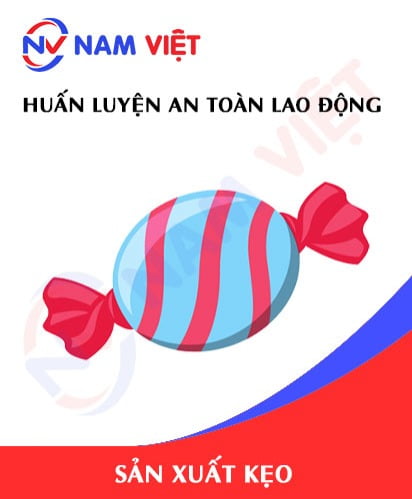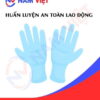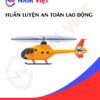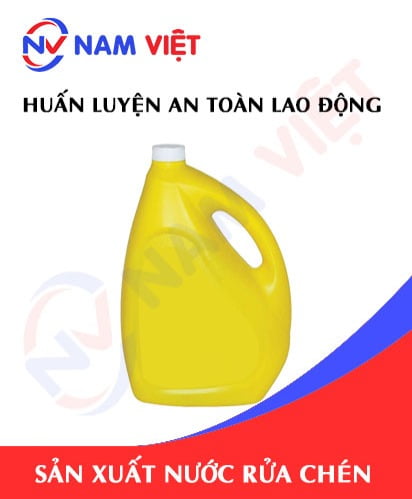Occupational Safety Training for Candy Manufacturing
99,000 ₫
Note: The price above is calculated per person and may vary depending on the number of trainees participating in the course and market fluctuations. For more accurate pricing support, please refer to the quotation list or contact our consultants directly.
Occupational safety is an important issue in candy manufacturing factories and needs to be addressed promptly to ensure the health and safety of workers, as well as to enhance the reputation of businesses. The Occupational Safety Training course is one of the effective solutions to raise awareness about preventing workplace accidents for workers involved in candy production.
Table of Contents
Toggle1. Overview of Candy
a. What is candy?
- Candy is a type of sweet food made from sugar, water, fruit powder, flavorings, humectants, and some other additives. Candy comes in many different shapes, colors, and flavors and is often used as a snack or as a gift for holidays, birthdays, and other special occasions.
- The candy manufacturing industry in Vietnam has been developing strongly in recent years. The consumer demand of the people is increasing along with the diversification of candy types and the trend of young people eating candy. In addition, Vietnam is also a country with diverse and rich raw materials, which is an advantage for developing the candy manufacturing industry.
- According to a report by market research company Euromonitor, in 2020, the value of Vietnam’s candy manufacturing reached more than 17 trillion VND and is expected to continue to grow in the future. Many enterprises in the candy manufacturing industry in Vietnam are also investing in improving product quality and expanding export markets.

b. Types of candy manufacturing machines
There are many different types of candy manufacturing machines, including:
- Candy mixer: Used to mix the ingredients of candy together, including sugar, syrup, water, flavorings, colors, and thickeners.
- Candy press: Used to press the candy mixture on a pressing table or under a pressing machine, creating different shapes and designs of candy.
- Candy mold press: Used to press the candy mixture into molds, forming different shapes and sizes.
- Candy roller: Used to roll and smooth the surface of the candy before cutting it into pieces.
- Candy cutter: Used to cut candy into pieces of different sizes and shapes.
- Candy coater: Used to coat a layer of sugar or chocolate on the surface of the candy.
- Candy packaging machine: Used to package candy into different containers, including nylon bags, paper boxes, or tin boxes.
- Candy quality inspection machine: Used to check the quality of candy after manufacturing, including its gloss, transparency, elasticity, and hardness.

c. Typical candy manufacturing enterprises
Currently, in Vietnam, there are many candy manufacturing enterprises, including large ones such as:
- Vinh Hao Coffee – Food – Seafood Business Co., Ltd. (Vinh Hao): manufactures candy products like Hong Hanh, Mr. Milky,…
- Mondelez Kinh Do Vietnam Co., Ltd.: manufactures Halls, Trident,… candies.
- Rong Vang Cotton Candy Co., Ltd.: manufactures Rong Vang cotton candy,…
- Bao Ngoc Trading Manufacturing Co., Ltd.: manufactures Skittles, Mars, Snickers,… candies.
- Duong Minh Co., Ltd.: manufactures Witor’s, Spomlek,… candies.
- Dabaco Vietnam Food Manufacturing Co., Ltd.: manufactures R&M, CocoMax,… candies.
- Bibica confectionery joint stock company.
- Hai Ha Confectionery Co., Ltd.
- Quang Ngai Sugar Joint Stock Company (Bicafun)
- Trang An Investment & Trading Joint Stock Company.
- Hai Chau Confectionery Joint Stock Company.
- A Chau Confectionery Co., Ltd. (ABC Bakery)
- Bao Minh Confectionery Joint Stock Company.
These are some typical candy manufacturing enterprises in Vietnam, but there are many other enterprises that manufacture different types of candy.
d. Specific jobs in a candy manufacturing factory
Group 1
- Executive director, deputy executive director, department manager in a candy manufacturing factory.
Group 2
- Safety officer: manages safety in the factory, designs safety procedures, supervises and urges employees to comply with safe work procedures.
Group 3
- Raw material preparation: After a manufacturing plan is in place, employees will prepare the necessary raw materials for the manufacturing process. Raw materials often include sugar, syrup, cornstarch, cassava flour, milk, and flavorings.
- Ingredient mixing: Ingredients are put into a mixer to be mixed evenly to create a uniform mixture. The mixing process usually takes about 15 to 30 minutes.
- Temperature adjustment: After mixing, the mixture will be put into a press and shaped into different forms. The pressing process often requires precise temperature to ensure product quality.
- Cutting and packaging: After the candy has been shaped as desired, it will be cut into smaller pieces and packaged. This process is usually done by machines to ensure accuracy and increase productivity.
- Quality inspection: Before products are put on the market, the manufacturer will inspect their quality to ensure they meet safety and quality standards.
- Machine maintenance: To ensure the smooth operation of machines, technicians will regularly inspect and maintain them to avoid breakdowns and minimize downtime.
Group 4
- Office jobs, service, sales, marketing.
- Quality management, human resource management, material management, financial and accounting management.
- Research and development of new products, design of product packaging.
- Manufacturing planning: Manufacturing specialists will create a manufacturing plan based on customer requirements and inventory status. This plan needs to include information on the quantity of products to be manufactured, the manufacturing time, and the amount of raw materials to be used.

2. Overview of the occupational safety training course for candy manufacturing
Within the scope of this article, we will focus on issues related to Group 3, because Group 3 is the group directly involved in the manufacturing process and bears the highest risk of occupational accidents. Refer to other groups here
a. What is Group 3 occupational safety training?
- Occupational safety training for Group 3 consists of training sessions that provide awareness on how to prevent occupational accidents for employees.
- The occupational safety training course will help employees recognize and avoid dangers, and minimize the risk of occupational accidents during work.
REGISTER FOR OCCUPATIONAL SAFETY TRAINING SERVICE
b. Training duration
Initial safety training duration
- The total training duration is at least 24 hours, including the test time.
- 8 hours of theoretical study on the system of occupational safety and hygiene policies and laws.
- 8 hours of theoretical study on basic knowledge of occupational safety and hygiene.
- 4 hours of theoretical study on specialized training content.
- 2 hours of practical training on specialized training content.
- 2 hours for the theoretical test at the end of the training course.
The safety training center will distribute the time into several training sessions depending on the time arrangement for the employees. However, there are usually 6 training sessions, and the course will last for 3 days, provided that the manufacturing company can arrange continuous study time.
Periodic safety training duration
- Before the occupational safety card expires, if an employee wants to have it reissued, they must go through a periodic occupational safety training course, with the periodic safety training duration being at least 50% of the initial safety training duration.
Explanation: The total periodic occupational safety training duration is at least 12 hours, including the test time. After completing the periodic training course and passing the test, the employee will have their occupational safety card reissued or renewed.
c. Content of the training course
| No. | TRAINING CONTENT | TRAINING DURATION (HOURS) | |||
| Total | Of which | ||||
| Theory | Practice | Test | |||
| I | System of occupational safety and hygiene policies and laws | 8 | 8 | 0 | 0 |
| 1 | Overview of the system of legal normative documents on occupational safety and hygiene. | 6 | 6 | ||
| 2 | System of occupational safety and hygiene technical standards and regulations. | 1 | 1 | ||
| 3 | Specific regulations of state management agencies on occupational safety and hygiene when newly constructing, expanding, or renovating works, and facilities for manufacturing, using, preserving, storing, and inspecting machinery, equipment, materials, and substances with strict requirements for occupational safety and hygiene. | 1 | 1 | ||
| II | Basic knowledge of occupational safety and hygiene | 8 | 8 | 0 | 0 |
| 1 | Basic knowledge of dangerous and harmful factors in the workplace. | 4 | 4 | ||
| 2 | Methods for improving working conditions. | 1 | 1 | ||
| 3 | Safety culture in manufacturing and business. | 1 | 1 | ||
| 4 | Rights and obligations of employers and employees; policies and regimes on occupational safety and hygiene for employees; functions and tasks of the occupational safety and hygiene network. | 1 | 1 | ||
| 5 | Occupational safety and hygiene regulations, occupational safety and hygiene signs and instructions, and the use of safety equipment and personal protective equipment; professional skills and first aid for occupational accidents, and prevention of occupational diseases. | 1 | 1 | ||
| III | Specialized training content | 6 | 4 | 2 | 0 |
| General knowledge about types of machinery, equipment, and substances that generate dangerous and harmful factors; analysis, assessment, and management of occupational safety and hygiene risks, and safe work procedures with machinery, equipment, and substances with strict requirements for occupational safety and hygiene. | 6 | 4 | 2 | ||
| IV | Test of safety training content at the end of the training course | 2 | 2 | 0 | 0 |
| Total | 24 | 22 | 2 | ||
See more training content for 6 groups
d. Occupational safety card
After completing the occupational safety training course and passing the test, the employee will be issued an occupational safety card (also commonly referred to as a Group 3 occupational safety certificate).
The Group 3 safety card will clearly show information such as: full name, date of birth, specific job, and working environment. It also has the training duration, a red stamp, and a signature confirming the completion of the training course.
According to the regulations on issuing safety cards specified in clause 2 of Article 24 of Decree 44/2016/ND-CP, there are two cases:
- If the employer and the employee have a labor contract with each other, the employer must sign, stamp, and initial the safety card for the trainee in Group 3 after they have completed the training course from an occupational safety training unit and passed the test.
- If the employee is a freelancer, a seasonal worker, and does not have a labor contract, the training unit must sign, stamp, and initial the safety card for the employee after they have completed the training course from an occupational safety training unit and passed the test.

3. Recognizing hazards when manufacturing candy
Candy manufacturing can have many potential hazards as follows:
- The use of fuel and gas during the candy manufacturing process can cause fire and explosions if not managed and used correctly.
- The use of chemicals during the candy manufacturing process, if not controlled properly, can cause contamination in the product.
- The use of candy manufacturing machinery and equipment can cause injuries to employees if occupational safety regulations are not followed.
- Dust and toxic fumes that can be generated during the candy manufacturing process can affect the health of employees and cause respiratory diseases.
- Failure to comply with food safety and hygiene regulations during the candy manufacturing process can lead to food poisoning and endanger the health of consumers.
- If the electrical equipment in the factory is not regularly maintained, not properly insulated, or not waterproof, it will pose a risk of electric shock to employees during manufacturing.
4. Common occupational accidents when manufacturing candy
Occupational accidents that often occur in the candy manufacturing industry may include:
- Injury from using machinery: Candy manufacturing machines can cause injuries to workers, especially when safety procedures are not fully followed. Injuries can include cuts, lacerations, burns, crushing, broken bones, or even death.
- Poisoning: The chemical products used in the candy manufacturing process can be toxic to humans. If the correct usage procedures and personal protection are not followed, employees can be poisoned.
- Electric shock: During the installation and use of electrical equipment in a candy manufacturing factory, electric shock can occur if the procedures are not correct and the employees are not fully trained in electrical safety.
- Accidents during transport: During the transport of candy products, traffic accidents or other accidents related to the transport process can occur, causing damage to the products and to the people involved in traffic.
- Infection: Poor hygiene conditions in a candy manufacturing factory can lead to infections for workers, especially diseases caused by bacteria and fungi.
5. Safety measures when participating in candy manufacturing
Safety measures when participating in candy manufacturing include:
- Workers need to be trained on the manufacturing process, equipment, occupational safety, and how to use safety equipment. Training and occupational safety training will help workers know how to detect and resolve dangerous situations as well as ensure their safety and the safety of others.
- Employees must use personal protective equipment such as helmets, safety glasses, masks, gloves, and safety shoes to protect their bodies from external factors such as toxic substances, high temperatures, or other risks.
- Manufacturing equipment needs to be regularly maintained and inspected to ensure it is always working properly and safely.
- The candy manufacturing factory needs to apply safety procedures such as emergency procedures, hazardous substance handling procedures, equipment repair procedures, and quality control procedures.
- The factory needs to conduct periodic safety inspections to ensure that the candy manufacturing process is always safe for employees and that the products meet quality requirements.
- Management must supervise workers to ensure they are complying with safety regulations and using personal protective equipment correctly. If there are any safety risks, workers need to be informed promptly and preventive measures should be taken.
- The candy manufacturing factory needs to perform periodic cleaning and disinfection to ensure food safety and hygiene when manufacturing candy.
- Periodically organize labor environment monitoring in the factory, collect and analyze harmful factors to employees, thereby adjusting to reduce the level of harm to prevent occupational diseases for them.

6. Benefits of occupational safety training for candy manufacturing
An Toan Nam Viet provides your company with great benefits after completing occupational safety training courses according to the regulations in Decree 44/2016/ND-CP on occupational safety and hygiene, for companies, factories, and enterprises.
- Employees can identify the potential risks of occupational accidents, from which they can take preventive measures to avoid occupational accidents.
- Your company can establish risk prevention measures in the manufacturing, operation, and maintenance processes.
- Reduce the costs incurred when safety risks in labor occur.
- Uninterrupted manufacturing will help increase labor productivity and product quality.
- Comply with occupational safety laws, avoiding legal risks.
- Create prestige and professionalism in all aspects, thereby enhancing your company’s brand.
Nam Viet’s training courses are solutions to prevent and combat external factors affecting each individual so that they can avoid danger that can lead to injury or, more seriously, death.
REGISTER FOR OCCUPATIONAL SAFETY TRAINING SERVICE
7. Customer feedback after completing the occupational safety training course for candy manufacturing
An Toan Nam Viet has many years of experience in the mission of accompanying many enterprises in Vietnam in general and in the southern provinces in particular. And that responsibility is something very precious to Nam Viet, which is why Nam Viet’s Occupational Safety Training work is always focused on becoming more and more professional. The motivation for An Toan Nam Viet to grow strong to this day comes from the positive feedback and suggestions from the enterprises. Below is the feedback from our valued partners that we have served.
Bac Nam E&C Construction Investment Joint Stock Company
“The first time using the service at An Toan Nam Viet, I was very surprised by the enthusiastic 24/7 support from the team of consultants. The class organization was very quick and convenient for our company, thank you very much for Nam Viet’s service!”
Hoa Dat Construction and Trading Joint Stock Company
“Nam Viet’s service has helped us a lot in simplifying occupational safety and the work of completing safety records for our work process. The consulting team is enthusiastic and responsive to our questions. 5 stars for Nam Viet.”
See more customer interviews after using An Toan Nam Viet’s service
8. Occupational Safety Training Competency of An Toan Nam Viet
An Toan Nam Viet is a reputable and high-quality occupational safety training center in Vietnam today. With occupational safety training sessions continuously taking place at manufacturing workshops, factories, or construction sites throughout the country (63 provinces and cities in Vietnam).
REGISTER FOR OCCUPATIONAL SAFETY TRAINING SERVICE
License for occupational safety training
- An Toan Nam Viet has been inspected and certified by the Department of Occupational Safety under the Ministry of Labor – Invalids and Social Affairs to be eligible to operate in occupational safety and hygiene training. This further strengthens our competency in occupational safety training.

Materials and lectures
- Before the occupational safety training materials are introduced into the occupational safety training courses, they are reviewed and censored to ensure that the lectures are always correct in terms of knowledge and effective when applied.
- The teaching method of the instructors is synchronized according to the teaching standards of An Toan Nam Viet, a method that experts in occupational safety and hygiene training have researched and summarized during the teaching process to bring the highest knowledge absorption efficiency to trainees.
Facilities
- Controlling the factors in the classroom that affect the training process will increase teaching performance and the knowledge absorption efficiency of trainees.
- The facilities supporting our training courses always arrange spacious classrooms that meet standards for area, lighting, training equipment, etc.
9. Reputable and high-quality nationwide safety training center
At An Toan Nam Viet, we always place professional dedication to occupational safety training as a top priority. For us, imparting knowledge on how to protect oneself to workers so they have a safe foundation on their livelihood journey is a contribution to building the country.
To ensure the training is effective, we prepare carefully and meticulously for every small detail. From preparing teaching tools, equipment, and materials to textbooks, documents, audio, and lighting.
Our occupational safety instructors are experts with many years of experience in the field. They even have research works identifying hazards in all occupations and how to prevent them.
The instructors’ lectures are summarized from practice and conveyed in the most vivid and easy-to-visualize way to the employees. These factors help employees feel comfortable during the learning time and absorb our teaching knowledge well. Of course, the knowledge conveyed always closely follows Decree 44/2016/ND-CP.
From there, they grasp many measures to prevent dangers and how to protect themselves. At the same time, they can apply it in the most suitable way in their actual work.
Our safety training center is proud to be a reputable and professional provider of occupational safety training services with the following advantages:
- Competitive training costs, but the training quality is still guaranteed.
- Flexible training schedule based on the manufacturing situation of the company.
- Fast and legally compliant procedures for issuing occupational safety training certificates.
- The instructors are people with many years of experience in the profession.
- The classroom environment is controlled for factors affecting the training process to increase teaching performance and the knowledge absorption efficiency of trainees.
- The lectures are compiled to be suitable for occupational safety work at enterprises.
- An Toan Nam Viet works with dedication and professionalism to support customers accurately and quickly.

10. Refer to more occupational safety training materials for candy manufacturing
- Occupational safety materials for candy manufacturing
- Occupational safety training materials
- Set of occupational safety training test questions
- Occupational safety multiple-choice test for candy manufacturing
- Slides of occupational safety training lecture for candy manufacturing
1 review for Occupational Safety Training for Candy Manufacturing
No comments yet















namchinh.haiphong341
Bài giảng rất sinh động!